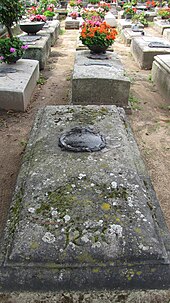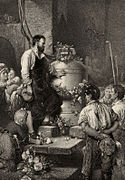Theodor Stroefer
Theodor Stroefer (also Ströfer ; born March 27, 1843 in Pyrmont , † July 9, 1927 in Nuremberg ) was a German publisher .
Life

Stroefer learned the trade of a publishing clerk with Friedrich Bruckmann in Munich. In 1866 he was sent by Bruckmann to New York City to set up a trading agency here on Broadway . He exported and imported pictures, illustrated books, albums, copperplate engravings and photographs. In 1871 he teamed up with Georg Kirchner, who immigrated to New York from Frankfurt (Oder) , and now traded as Stroefer & Kirchner .
Stroefer returned to Germany in 1876 and opened a Stroefer & Kirchner branch in Munich at Schwanthalerstraße 34 . One of the first projects was the edition of Viola Tricolor by Franz Graf von Pocci . In the following year Stroefer and Kirchner split the company: Stroefer was now under the company Theo. Stroefer's Kunstverlag is solely responsible for European business and Kirchner under the Geo company . Kirchner & Co. for North America.
In 1893 Stroefer moved the headquarters of the art publisher to Nuremberg and intensified his collaboration with the art institute for graphic reproductions by Ernst Nister (1842–1909).
Stroefer died in 1927 and was buried in the Nuremberg Johannisfriedhof (grave site I / 1230).
Theo. Stroefer's art publisher
The publishing program was broad. The most famous and formative for the period from 1876 to 1890 were the magnificent volumes, first Goethe's Faust (1876), then Schiller's Das Lied von der Glocke , each opulent with drawings by Alexander von Liezen-Mayer and ornaments by Rudolf von Seitz , as well as Schiller's Wilhelm Tell , with ten photographic collotype prints and 16 woodcuts by Friedrich Schwörer (1879). In 1888 the praise of the virtuous woman appeared with a text by Karl von Gerok and illustrations (30 compositions, executed in 8 heliogravures and 22 clay print images) by Ludwig von Kramer .
Signet of the art publisher
A large part of the program included artistically designed children's books, for which Ernst Nister in Great Britain often selected the templates. In 1880 Stroefer published the German first editions of Kate Greenaway's birthday book for children and Am Fenster , with which her photolithographs came to Germany. The German translation of Am Fenster was created by Käthe Freiligrath-Kroeker, Ferdinand Freiligrath's daughter, who lives in London . An overview of the publishing offer of children's books for Christmas 1894 decide Westermann's Monatshefte with the assessment: "The publisher of Theodor Stroefer in Nuremberg it can be really be set to provide a wide range of thoughtful and tasteful Party gifts available." Stroefer developed around the turn of the 19th to the 20th century in the field of children's books "into one of the leading companies in the industry". One of the authors was Ottilie Schwahn , who published 22 volumes here between 1889 and 1903.
There were also picture and art postcards in many versions at Stroefer. The artists represented in the area of artist postcards included Nathaniel Sichel , Raphael Kirchner , Alexander Kircher and Arthur Thiele .
And finally, Stroefer was the first publisher of Max Klinger's etching cycles . In 1881 he published Klinger's Intermezzi (Opus IV) .
After Theodor Stroefer's death, his son August Stroefer (* 1882; † October 5, 1945) took over the company, which moved to Maxtorgraben 3a in 1939 . The business premises and the publishing archive were completely destroyed at the end of the Second World War. The art publisher was deleted from the commercial register in 1958 .
Art collection
Around 1870 Stroefer started collecting arts and crafts, paintings and sculptures. Most of the works of art were acquired in the last three decades of the 19th century, but it wasn't until the First World War that the further expansion of the collection ended. After Stroefer's death, the collection remained as a family property - known only to a few connoisseurs - initially closed in his Nuremberg house. Top pieces were Dutch paintings from the Golden Age by painters such as Frans Hals , Jan Steen , Adriaen Brouwer , Rembrandt and Ruisdael . In 1937 it was auctioned in two departments: the Munich auction house Adolf Weinmüller auctioned the arts and crafts from October 21 to 23, 1937, and Julius Böhler's paintings and sculptures on October 28, 1937.
literature
- Stephanie Schilling: The children's book publisher Theodor Stroefer. Publishing history and analysis of publishing production. MA thesis, Erlangen (Ms. masch.) 1987.
- Eva Klose: Artist and picture postcards for Hungary in the art publisher Theodor Stroefer. In: Christa Pieske, Konrad Vanja, Sigrid Nagy (eds.): Conference proceedings Budapest 2003. (Working group image printing paper, volume 8) Waxmann 2004, ISBN 978-3-830-91454-9 , pp. 135–140.
- Eva Klose: The collaboration between the art publishers Theo. Stroefer and Ernst Nister in Nuremberg. In: Wolfgang Brückner, Konrad Vanja, Detlef Lorenz, Alberto Milano, Sigrid Nagy (eds.): Working Group Image Print Paper - Conference Proceedings Nuremberg 2009. (Working Group Image Print Paper, Volume 14) Waxmann 2010, ISBN 978-3-830-92329 -9 .
Estate auctions
- Julius Böhler (Ed.): Theodor Stroefer Collection, Nuremberg: [voluntary auction of the old paintings and sculptures in the Theodor Stroefer Collection, Nuremberg by Julius Böhler… October 28, 1937 ] . Europeana. Retrieved June 2, 2012.
- Munich art auction house Adolf Weinmüller (ed.): Theodor Stroefer collection, Nuremberg: old arts and crafts (catalog no. 10) . Europeana. Retrieved June 2, 2012.
Web links
Individual evidence
- ^ Digitized , see also Flowers for the Faculty
- ^ Digitized version of the 1887 edition in the Duchess Anna Amalia Library
- ↑ digitized version
- ^ Karl Gerok (text), Ludwig von Kramer (illustrations): The praise of the virtuous woman. Proverbs Solomon 31st verses 10–31 . Munich 1885 ( digitized )
- ↑ See magazine for literature from abroad. 49 (1880), p. 425
- ↑ Westermanns Monatshefte 75 (1894), pp. 525f
- ^ Christina Hofmann-Randall: Franconian children's books from five centuries. (Writings of the University Library Erlangen-Nürnberg 40) Erlangen: University Library 2001, ISBN 9783930357468 , p. 34
- ^ Max Klinger: Intermezzi, opus IV (1881) in the Museum of Modern Art
- ↑ See the catalogs (lit.), digitized by the University of Heidelberg
| personal data | |
|---|---|
| SURNAME | Stroefer, Theodor |
| ALTERNATIVE NAMES | Ströfer |
| BRIEF DESCRIPTION | German publisher |
| DATE OF BIRTH | March 27, 1843 |
| PLACE OF BIRTH | Bad Pyrmont |
| DATE OF DEATH | July 9, 1927 |
| Place of death | Nuremberg |







